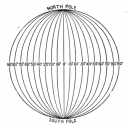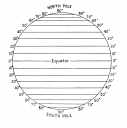Basic Geography: Latitude and Longitude
Latitude defines how far north or south a point is on the globe relative to the equator. As many of us are aware, the equator is an imaginary line drawn around the earth equally distant from both poles, dividing the earth into Northern and Southern hemispheres. To put it plainly, latitude lets you know how far north or south a point is on the globe.
Latitude is expressed in degrees, with the equator sitting at 0° latitude. As you move north, the degrees go from 0 to 90°. However, they go up to 90 as you move south as well. Therefore, in order to tell whether a point is north or south, you would say its latitude is so and so degrees North, as in north of the equator, or so and so degrees South, as in south of the equator.
Before we move onto longitude, here's one little tip: in order to keep latitude lines straight from longitude ones, I like to link the 'a' in latitude to the 'a' in the word 'across', helping me to remember that latitude lines go across the globe. Another great way to remember latitude is to link it to a ladder whose rungs run across it.
Longitude defines how far east or west a point is on the globe relative to the prime meridian. The prime meridian is, again, an imaginary line drawn around the earth that separates it into eastern and western hemispheres. To state it simply, the prime meridian is to east and west what the equator is to north and south.
Interestingly, the prime meridian is believed to pass directly through Greenwich, England. Therefore, it is often also called the Greenwich meridian.
Like latitude, longitude is also expressed in degrees. However, as latitude only goes from 0 to 90° north or south, longitude goes from 0 to 180° east or west. Again, just like latitude, longitude will be expressed as so and so degrees east or so and so degrees west.
So you're looking at a map and you want to know where a city or a place is. And you want to tell someone else. How do you do it?
Let's say you want to tell your friend where Paris is.
You could say, "Well, it's in France." That's general.
You could say, "OK, find the Seine River." That might work.
But what if your friend wants to know exactly where Paris is? You need to use latitude and longitude.
Latitude and longitude are two of the most basics terms in all of geography. To understand them, you need to think of Earth as a globe. Further, you need to think of the globe as divided into lots of little sections. Some go east. Some go west. Some go north. Some go south.

(Note: A little bit of math is coming. Don't be scared!)
So, you know how a circle has 360 degrees? Well, that's true for Earth as well. If you put your finger on the city of Paris and trace all the way around the globe, from right to left, you will trace the full 360 degrees. Go just halfway and you get 180 degrees.
You have just traced 360 degrees of longitude. Longitude is lines that run north and south that measure east or west. The Prime Meridian, in Greenwich, England, is at 0 degrees longitude.

Put your finger on Paris again. Trace around the globe, this time going around the top of the globe, then around the bottom, and back to Paris. You've just traced the full 180 degrees of latitude. Latitude is only 180 degrees. Latitude lines run east and west and measure north or south. The Equator is at 0 degrees latitude.
What does all this give us? Well, you want to tell your friend exactly where Paris is, right? So check out a map that has latitude and longitude marked on it. You'll find that the latitude and longitude markings are every 10 degrees. (Some maps have markings for every 15 degrees or even every 5 degrees.)
See how Paris is almost halfway between 45 degrees and 50 degrees markings? You'll have to estimate here. It's probably about 47.5 degrees. Let's call it 48.
That's latitude. What about longitude? Well, the Prime Meridian is at 0 degrees. That's in England. France is just east of England (for the most part). See how Paris is just less than halfway between the 0 degrees and 5 degrees markings? You'll have to estimate here, too. It's probably about 2 degrees.
So, what is the exact location of Paris? Well, geographers tell us that Paris is indeed at 48 degrees north and 2 degrees east.
Latitude and longitude are big words, but now you know what they mean. Amaze your friends!
Post a Comment